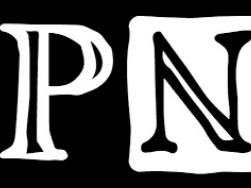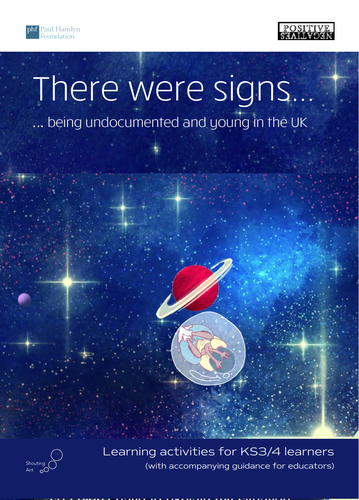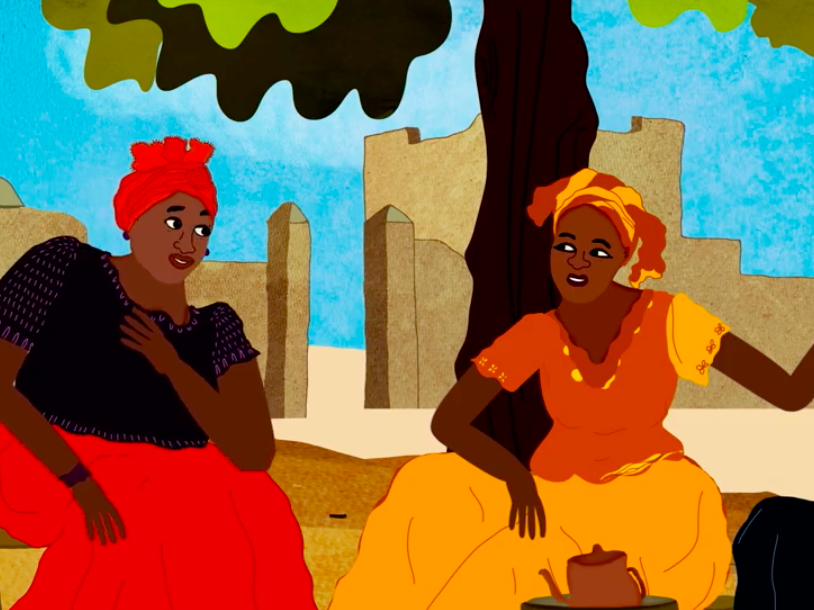
6Uploads
6k+Views
33k+Downloads
All resources

'Maths of Migration'
This is part of a series of cross curricular lessons looking at stories of migration. The series is freely available - with more subjects being added in due course.
NOTE: these issues may resonate with some learners, and some viewers may find the animation traumatic. Please watch it before showing to your class, and consider alerting learners of its nature before viewing.
For more educational activities and videos bringing to life humanitarian, social and other contemporary issues, please visit PositiveNegatives education.
This educational activity was created with Oaklands School. The data is from MEDMIG, led by Professor Heaven Crawley PhD. The North Star Fading animation is created by Karrie Fransman for PositiveNegatives.

Citizenship/Young Unaccompanied Asylum Seeker Unit of Work
Suggested key stages: 3 & 4.
Subjects: Citizenship, PSHE, SMSC (including Values), English, Media Studies.
This resource has been created to support learners at key stages 3 & 4, and their educators, to engage with the situation facing unaccompanied young people who arrive as asylum seekers in the UK. The resource is built around a short animation called ‘Dear Habib’ that shares the story of one young person and their experience of coming to the UK.
It is a suite of 7 activities with an accompanying introduction and guidance notes for teachers, and a supporting Safe Space resource that is useful for this type of learning. Across the activities, this resource responds to learning and teaching in Citizenship, Media Studies, English, SMSC (including values) and PSHE, with suggested learning pathways for each of these included in the introductory overview.
Through engaging with this resource, learners will develop their understanding of unaccompanied young people, build their concern and compassion for this issue, respond in a variety of creative forms, reflect on their own character, resilience and citizenship. A full breakdown of learning outcomes is included in the introductory overview.
The individual activities within this suite can be used in isolation, but we strongly advise that educators read the introductory overview to appreciate the full learning potential of the resource.
Common guidance
As the content covered by these resources could be considered controversial or sensitive, we recommend that all educators take a few minutes to read through the following ‘Creating Safe Spaces’ document before using any of the activities with learners.
This resource was produced in partnership with Rosie Wilson and Rob Bowden of [Lifeworlds Learning] (http://www.lifeworldslearning.co.uk/) and Shouting Ant.
For more free educational activities bringing to life social, humanitarian and other contemporary issues, please visit PositiveNegatives education.
PositiveNegatives is a not-for profit collaborating with educators, artists and researchers creating true stories, drawn from life to inspire empathy, critical thinking and creativity. Those stories, and the educational resources are freely available, and published under Creative Commons licenses. For feedback, suggestions or more information please contact us.

Creating Safe Spaces
Dealing with challenging and/or controversial issues can lead to strong emotional (and sometimes very personal) responses from learners. It is important that educators/facilitators are able to support learning communities to engage with these issues in a caring, but still critical manner. This activity looks at how active consideration and co-creation of a ‘safe space’ can be an effective way to achieve this.
PositiveNegatives is a not-for profit collaborating with educators, artists and researchers creating true stories, drawn from life to inspire empathy, critical thinking and creativity. Those stories, and the educational resources are freely available, and published under Creative Commons licenses. For feedback, suggestions or more information please contact us.

Ola- There Were Signs: Citizenship & Irregular Status Activities
This resource has been created to raise awareness about young people living in the UK who may be undocumented (also known as having ‘irregular status’). It is aimed at learners in key stage 4, aged 14-16 years, and for those that educate them. The resource is built around a short animation called ‘There were signs’ that shares insights into the lives of undocumented young people in the UK.
The content of this resource may include concepts, terminology and areas of learning that are relatively new to both learners and educators. We therefore signpost to various other forms of support that you may wish to use alongside this resource in order to maximise the learning potential for your learners.
All of the ideas and activities within this resource are offered as ideas, and we fully expect that educators will select and further adapt the materials to suit their learners and personal teaching styles.
Each activity shows the approximate time suggested to complete it, ranging from 10 to 30 minutes. The overall resource has been designed for delivery in approximately two hours meaning it could be used for a double lesson, two single lessons, or across several form/tutor sessions. It would also lend itself to forming part of an off-timetable day such as a Citizenship day.
Common guidance
As the content covered by these resources could be considered controversial or sensitive, we recommend that all educators take a few minutes to read through the following ‘Creating Safe Spaces’ document before using any of the activities with learners.
These resources were created by Lifeworlds Learning.
For more free educational activities bringing to life social, humanitarian and other contemporary issues, please visit [https://positivenegatives.org/about/education/]).
PositiveNegatives is a not-for profit collaborating with educators, artists and researchers creating true stories, drawn from life to inspire empathy, critical thinking and creativity. Those stories, and the educational resources are freely available, and published under Creative Commons licenses. For feedback, suggestions or more information please contact us.

Diverse Places: Exploring Islam on campus (A level Geography: Changing Places)
This is an A level Geography Lesson on Diverse Places, as part of the Changing Places unit. The lesson explores the ideas of place-making, place and scale in relation to identity, belonging and a local area - using research on how Islam is experienced on Campus.
This lesson is built around the animation, Outside the Box, which explores how Islam is experienced and understood on campuses across the UK.
Common guidance
As the content covered by these resources could be considered controversial or sensitive, we recommend that all educators take a few minutes to read through the following ‘Creating Safe Spaces’ document before using any of the activities with learners.
For more free educational activities bringing to life social, humanitarian and other contemporary issues, please visit PositiveNegatives education.
PositiveNegatives is a not-for profit collaborating with educators, artists and researchers creating true stories, drawn from life to inspire empathy, critical thinking and creativity. Those stories, and the educational resources are freely available, and published under Creative Commons licenses. For feedback, suggestions or more information please contact us.
This educational activity was created in collaboration with Dr Shereen Fernandez. The data is from SOAS-based research project, Re/presenting Islam on Campus, led by Professor Alison Scott-Baumann, SOAS. Outside the Box was created by PositiveNegatives, creative directed and illustrated by Sabba Khan.

Choosing A World Free From Female Genital Cutting
This resource has been created to support learners at key stages 3 & 4, and their educators, to engage with FGC - female genital cutting - as a global citizenship and human rights issue that affects everyone. The resource is built around a short animation called ‘Aissata’s True Story: Choosing a world free from FGC’ and an accompanying comic version of the animation.
The content of this resource may include concepts, terminology and areas of learning that are relatively new to both learners and educators. FGC is a serious and sensitive issue and because of this we have worked closely with educators and experts in supporting those subjected to FGC in order to suggest a learning pathway through this resource.
Common guidance
As the content covered by these resources could be considered controversial or sensitive, we recommend that all educators take a few minutes to read through the following ‘Choosing a World Free From Female Gential Cutting’ resources before using any of the activities with learners
These resources were created by Lifeworlds Learning.
For more free educational activities bringing to life social, humanitarian and other contemporary issues, please visit [https://positivenegatives.org/about/education/]).
PositiveNegatives is a not-for profit collaborating with educators, artists and researchers creating true stories, drawn from life to inspire empathy, critical thinking and creativity. Those stories, and the educational resources are freely available, and published under Creative Commons licenses. For feedback, suggestions or more information please contact us.






